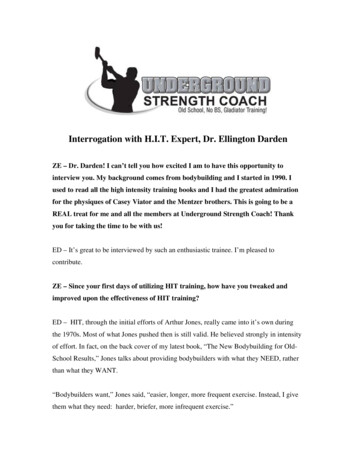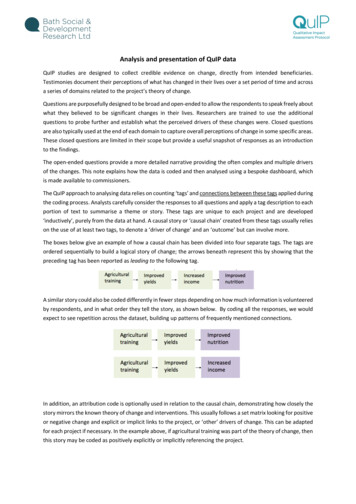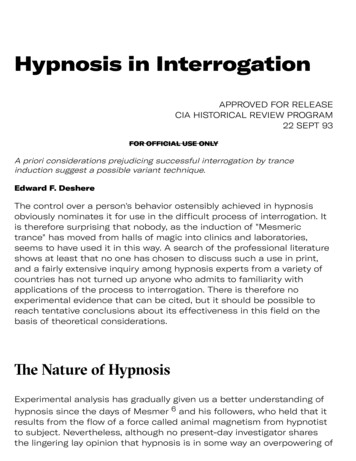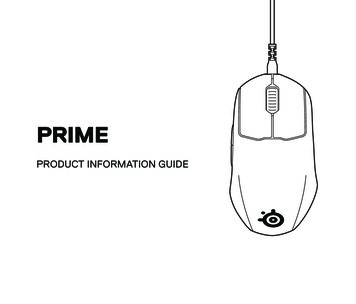
Transcription
Interrogation with H.I.T. Expert, Dr. Ellington DardenZE – Dr. Darden! I can’t tell you how excited I am to have this opportunity tointerview you. My background comes from bodybuilding and I started in 1990. Iused to read all the high intensity training books and I had the greatest admirationfor the physiques of Casey Viator and the Mentzer brothers. This is going to be aREAL treat for me and all the members at Underground Strength Coach! Thankyou for taking the time to be with us!ED – It’s great to be interviewed by such an enthusiastic trainee. I’m pleased tocontribute.ZE – Since your first days of utilizing HIT training, how have you tweaked andimproved upon the effectiveness of HIT training?ED – HIT, through the initial efforts of Arthur Jones, really came into it’s own duringthe 1970s. Most of what Jones pushed then is still valid. He believed strongly in intensityof effort. In fact, on the back cover of my latest book, “The New Bodybuilding for OldSchool Results,” Jones talks about providing bodybuilders with what they NEED, ratherthan what they WANT.“Bodybuilders want,” Jones said, “easier, longer, more frequent exercise. Instead, I givethem what they need: harder, briefer, more infrequent exercise.”
2Zach, in my opinion, that’s still some of the best advise a bodybuilder can apply.But back to your question on how I’ve tweaked and improved HIT?Jones started me, and many others, thinking in the direction of harder and brieferexercise. I’m not quite as strict as Jones was and I respect more of the scientific findingsthat have occurred over the last 25 years. Today, I know many types of weight-trainingsystems produce positive changes in the human body – including multiple sets, splitroutines, high repetitions, low repetitions, fast and slow styles, and training to failure andnot training to failure.Lots of things work, at least for a while. But once you get my age, 64, you better makedamned sure that your bodybuilding and strength training haven’t mangled and destroyedyour joints and muscles in the process of building them.This shot was inspired by Joe Weider's magazines, where thegood - looking gal is admiring the muscle man. I hadrecently won the 1969 Mr. Texas contest and I was with a 2007http://UndergroundStrengthCoach.com
3group of my friends at the beach in Panacea, Florida. Atthat time, I was 5' 11" tall and weighed about 200 pounds.ZE – Dr. Darden, let me stop you for a minute. Before you get into some relatedissues, can you clarify exactly what it takes for weight training to build muscle?ED – Sure. Without getting too complicated, I want to answer your question as it appliesto advanced bodybuilders. Why advanced bodybuilders? Because most guys, who’vebeen involved with training for even a little while, know that it’s fairly easy for beginnersto make progress.If a beginner is consistent, he can – in a matter of two to three months, add five or morepounds of solid muscle to his body. Then, he reaches a plateau, and it becomes moredifficult. If he, an intermediate now, doesn’t know what he’s doing, it may take him ayear to add another 5 pounds – and if it takes that long, he’s probably NOT going to stickwith it. And even if it does, that next level – advanced – is going to be much moredifficult to add significant muscle.In chapter 7 of my new book, a longtime HIT enthusiast and trainer, Bill De Simone ofPrinceton, NJ, boils down the muscular-growth process to two factors.First, you need heavy repetitions, performed within the anaerobic pathway of 30 to 90seconds, to involve as many of the fast-twitch muscle fibers as possible. The fast-twitchfibers have the most potential for growth.Second, you can further stimulate fiber size by extending your normal set into an inducedburning state, which triggers remodeling/repair through hormonal response.I believe De Simone is on-target with advanced bodybuilders. In summary, he saysyou’ve got to lift heavy for at least 30-seconds worth of repetitions . . . and then, some ofthe time, continue a set – with such techniques as negatives, pre-exhaustion, andbreakdowns. 2007http://UndergroundStrengthCoach.com
4In my opinion, De Simone’s concepts help update Arthur Jones’s findings from the early1970s, especially as they relate to experienced trainees.ZE – The majority of people I know who currently use HIT or have used HIT arebodybuilders. Here and there I hear of some Performance Coaches using HIT forathletes. Can HIT be effectively used for athletes or does the constant practice oftheir sport interfere with the gains that can be made due to recovery issues?ED – HIT, during the 1970s, was used as much by sports coaches, as by bodybuilders.Nautilus worked closely with the Miami Dolphins, Cincinnati Bengals, Chicago WhiteSox, New York Yankees, and numerous college and high school sports teams. Werecommended that most athletes strength train twice a week – the day after the game andthree days later.And you’re right. Recovery can be an issue. That’s why it’s important to keep theworkouts hard and brief.ZE – I recall reading the exact stories and workouts of Casey Viator as he preppedfor the Mr. America at age 19. Those workouts were full body and he was builtmore rugged than any other man I have seen! I have experienced great gains usingHIT but splitting up the body into 4 different workouts! Have you found throughexperience a certain split to be optimal for strength and muscle gains?ED – I’ve got mixed emotions concerning split routines. I know that’s what mostbodybuilders demand. Split routines allow guys to spend more time in the gym, whichhelps them fulfill those WANTS (easier, longer, more frequent exercise) that ArthurJones described on the back of my book. But most split routines lead to overtrainingand/or a reduction in the intensity of the exercise – both of which hurt your overallresults. 2007http://UndergroundStrengthCoach.com
5At the same time, I realize that most trainees appreciate variety, and split routines offer alot of variation. What I’ve done in my book is to assemble A, B, and C versions of basicwhole-body routines. You’re still working both your lower and upper bodies during thesame workout – but you have variety from the application of different exercises andtechniques.Bottom line: Most of the bodybuilders from the old school, the 1940s and 1950s, usedwhole-body training three times per week. And it worked very well for them. Of course,these guys understood the basics and the need for hard work.If you're a fan of underground old-school training, you'llappreciate most of the equipment in this photo. I took thispicture in Cincinnati at the home gym of Kim Wood, who wasan NFL strength coach for 28 years. I interviewed Wood inchapter 2 of my new book. 2007http://UndergroundStrengthCoach.com
6The large blue dumbbells on the floor are from the MiloBarbell Company, which was started by Alan Calvert in 1902.Above the dumbbells, resting on boxes, is a huge globebarbell, which was lifted in the early 1900s by strongmanWarren Lincoln Travis. Above the Travis barbell are severalMilo Tri-Plex and Du-Plex barbells, as well as severalsolid Sandow barbells from England. Along the backwindows are some chromate-finished kettlebells from BlackIron Strength and on the floor are globe dumbbells andbarbells made by Osmo Kiiha. On the racks to the near rightare retro barbells from Atomic Athletic.ZE – With the new influx of exercise equipment and all the different training toolsavailable nowadays, what tool(s) do you prefer to use for HIT training and why?ED – From 1958 to 1970, I trained with barbell and dumbbells. From 1971 to 2007, Iused mostly Nautilus machines. I’ve had a lot of experience with both free weights andmachines. I’ve learned from my more than 45 years of training, that the equipment is notas important as the way you apply whatever equipment you have. You can get goodresults from free weights and you can get good results from machines. Or you canachieve little or no results from either one.But if everything is equal and you have a choice between both – then 9 times out of 10,I’d go with machines. Why? Because properly designed machines are more effective,more efficient, and safer than similar free-weight exercises.In my home gym, I have seven Nautilus machines, a Bowflex machine, a thick-handlebarbell with 100 pounds of plates, and a pair of hand grippers. 2007http://UndergroundStrengthCoach.com
7An interesting photo montage of Arthur Jones, taken in 1983, as hesupervised the training of an athlete.ZE – Let’s take a look at specific workouts if possible. Let’s take an advancedathlete, such as a college football player. He has access to barbells and dumbbellsonly. How would a workout look for this athlete and if possible let’s touch upon howlong this program lasts before we change exercises.ED – Okay, assuming he’s in descent shape, I’d start him off with ten basic exercises,such as the following:1. Squat2. Calf raise3. Pullover with one dumbbell4. Overhead press 2007http://UndergroundStrengthCoach.com
85. Bent-over rowing6. Bench press7. Shoulder shrug8. Biceps curl9. Triceps extension with one dumbbell10. Stiff-legged deadliftHe’d do one set of each exercise with as much weight as he could handle for 8 to 12repetitions, in good form. Good form would be smooth and slow on both the lifting andthe lowering, making sure that the turnarounds are deliberate, with no jerking orbouncing. Overall, each rep would take approximately 5 seconds to perform . . . which is2-3 seconds on the positive and 2-3 seconds on the negative.The HIT philosophy is based on going to momentary muscular failure, “where he can nolonger complete the positive phase without cheating,” which usually requires somespecific coaching for most football players to get the hang of, since they are used toslamming and throwing many of their repetitions.Another important HIT principle, “as an athlete gets stronger, he must reduce hisfrequency,” now comes into action. I’d start this football player doing all those tenexercises three times per week, until he reached a plateau on half of the exercises. Whenthat occurred, I’d reduce his frequency from three times per week, which is six times intwo weeks, to five times in two weeks. After another plateau is reached, I’d reduce him totwice-a-week training.After two months of the above, I’d subtract and add some new exercises, such as thelateral raise, bent-arm fly, wrist curl, reverse curl, side bend, and possibly the legextension and leg curl, if those machines are accessible, as well as some type of neckexercise. Then, I’d bring in some of the advanced techniques – such as pre-exhaustion,breakdowns, and negatives – to extend the set into that burning state for better results. 2007http://UndergroundStrengthCoach.com
9ZE – If one were to specialize on a certain body part, how would we use HITprinciples for this area? The training is already expected to be very intense so howelse would we alter the HIT methods? Also, how long can we specialize in a certainbody part with HIT training or does it depend on the muscle being focused on?ED – Generally, most HIT routines are performed by starting with the largest musclegroups and finishing with the smallest. In other words, work the lower body before theupper body and the torso before the arms.In a specialized routine, for example the upper arms, I’d move the arm exercises to thebeginning of the workout. Plus, I’d eliminate a couple of the exercises from the torso andlegs – so the routine would be shorter.Specialized routines are designed to be applied twice a week for no longer than twoconsecutive weeks. Then, you go back to the basic routine for a month or so before youspecialize on another body part.ZE – When you have an athlete who is injured, either through the training itself orthrough an outside incident, how do you adjust HIT to work around the injury ordo you take this as a sign to completely rest the body until healed?ED – I would not usually have an athlete completely rest his body after an injury, at leastno longer than a day or two. If he has an injury to his right knee, for example, he canwork his upper body. And with precautions taken, he can still train his left leg on certainexercises. Strength-training machines are usually more appropriate in such arehabilitation setting.Depending on the injury, but usually within a couple of weeks, I’ll have an athlete beganexercising the injured area by focusing only on the lowering or negative phase of relatedexercises. It’s important to begin such lowering in only the pain-free ranges of 2007http://UndergroundStrengthCoach.com
10movement. Again, such training can be performed much better with machines than withbarbells and dumbbells.ZE – Give us a HIT story from the “Golden Era” – what was it like back in the 70’swhen Mike Mentzer and Casey Viator were wowing the world with their ruggedphysiques? Do you have any moments or workouts in particular that stand out fromthe rest?ED – Yes, I remember well one training situation. It was in January of 1978. Bill Veeck,the owner of the Chicago White Sox baseball team, had four of his best players come tothe Nautilus headquarters in Lake Helen, Florida. Each guy needed a little extraconditioning before Spring Training in Sarasota. The year before, I had successfullyrehabbed Eric Soderholm’s left knee to the point that he was one of the strongest men inbaseball. And it showed because he won the American League’s Comeback Player of theYear Award in 1977.I’m in the gym with the four White Sox players, including Soderholm, and I have justsupervised the players through a HIT workout – except for one last exercise, negativeonly dips. There’s a Nautilus machine, called the Multi-Exerciser, which has a paddedbelt attached to a resistance arm with steps at the bottom, so it’s great for negative chinsand dips.All of the guys, with the exception of Soderholm, have tried a slow-lowering rep with 40pounds attached to their waist . . . and believe me negative-only dips can be tough to doat the end of workout. The three baseball players have struggled – just to do one SLOWrepetition.Now I bring on Soderholm. A year earlier, Eric did negative dips with 130 pounds aroundhis waist. To remain conservative, I put 100 pounds on the machine, and ask him to do 8,which he does in good form. Then, I explain to the group that it’s possible for each one ofthem, to double his dipping strength, to go from 40 to 80 pounds, in as little as four 2007http://UndergroundStrengthCoach.com
11weeks. And doing so, I note, will make each baseball player bigger, stronger, and lessprone to injury.As I’m finishing my discussion, Casey Viator enters the room with his gym bag in hand.It’s his workout day and he’s going to change clothes and train. But first I ask Casey tocome over and I introduce him as the winner of the 1971 Mr. America. I can tell that thebaseball players are in awe of his 15-inch forearms and 19-inch upper arms.Viator is friendly and he asks what’s going on. I give him a quick summary . . . and then Isay:“Casey, why don’t you show the guys how you can do a set of negative-only dips withthe entire weight stack?” A couple of weeks earlier, I’d seen Casey do negative dips withthe weight stack (250 pounds), at the end of his workout, so I knew it would be no bigdeal for him to do it first.Viator drops his bag, steps into the belt, adjusts it with 250 pounds around his waist,climbs the steps to the top, and does a perfect 8-second lowering repetition. Once he’s inthe bottom, stretched position, he says, “What the heck,” and smoothly pushes himself tothe top position. Rather than climb back with his legs, he uses his arms in a positivemanner. He then does 9 more down-and-up reps in good form – without breaking asweat.Forget negative-only dips.Viator did 10 normal dips with 250 pounds around his waist, which was one of the mostimpressive strength feats I’ve seen in my 45 years of being around great athletes. Thatday, I believe he could’ve done 10 reps with 300 pounds.Mike and Ray Mentzer were also very strong in dips. Each one of them could do 3 or 4reps with 250 pounds – but not 10. 2007http://UndergroundStrengthCoach.com
12 2007http://UndergroundStrengthCoach.com
13 2007http://UndergroundStrengthCoach.com
14Casey Viator as he looked several months before he won the1971 AAU Mr. America, at 19 years of age. Viator weighed215 pounds and had 19-inch upper arms and 15-inch forearms.ZE – Dr. Darden, thank you once again for taking time away from your busyschedule to answer all these questions. As a pioneer and innovator I want you toknow you have been a very large part of my motivation into the world ofperformance and physique improvement since my very first days picking up abarbell! Please let our readers know where they can learn more about you, yourweb site and any products that they can learn from.ED – Thanks again, Zach, for your interview. I invite all your readers to visit my Website, www.DrDarden.com. HIT has a lot to offer to athletes and coaches. And yourreaders, who are particularly interested in bodybuilding, should get my latest book, “TheNew Bodybuilding for Old-School Results,” which they can order through my Web site.The book helps supply bodybuilders, not with what they WANT, but with what theyNEED:Harder and briefer training.For the most innovative information in performance training, strength andconditioning visit the one and only, http://UndergroundStrengthCoach.com 2007http://UndergroundStrengthCoach.com
damned sure that your bodybuilding and strength training haven’t mangled and destroyed your joints and muscles in the process of building them. This shot was inspired by Joe Weider's magazines, where the good - looking gal is admiring the muscle man. I had



